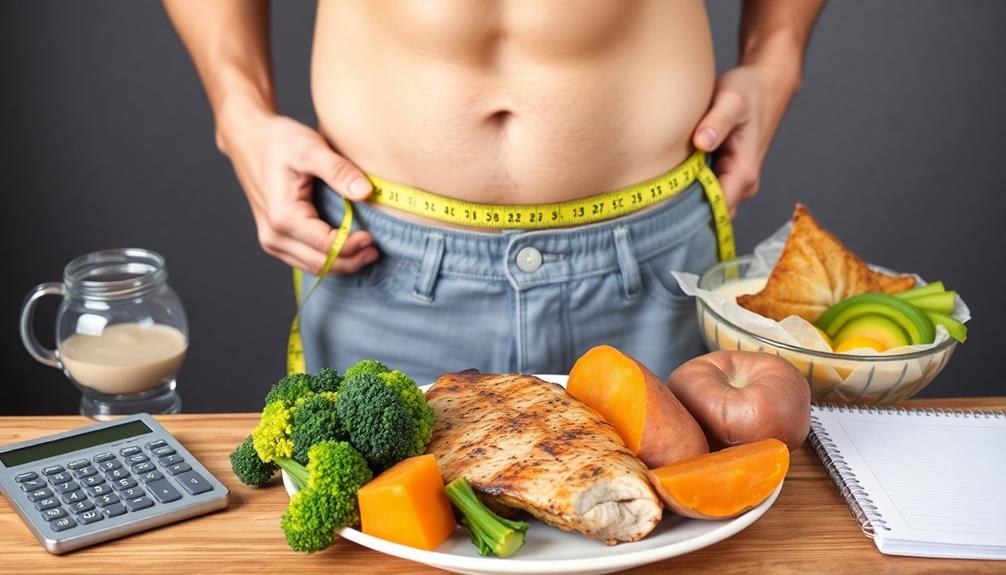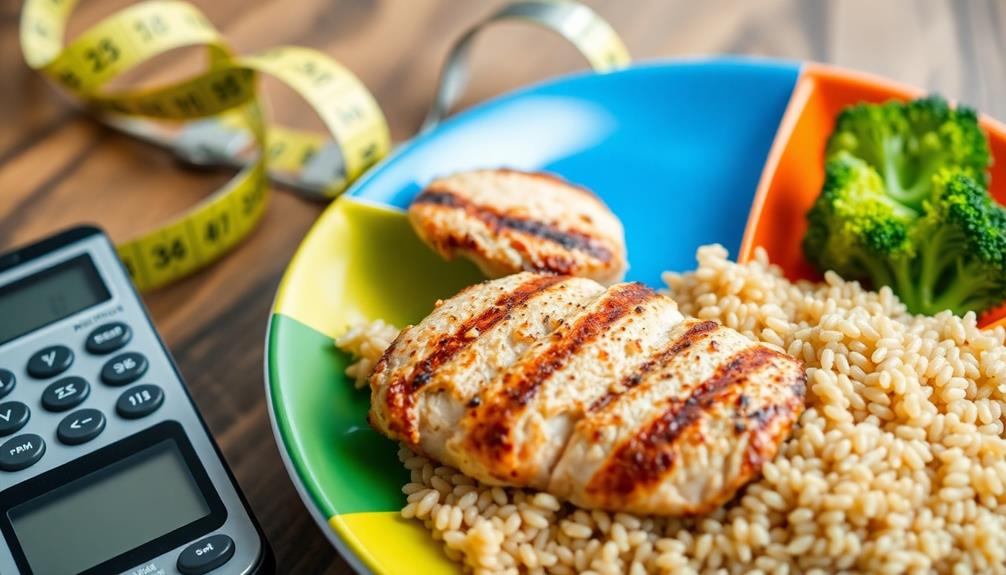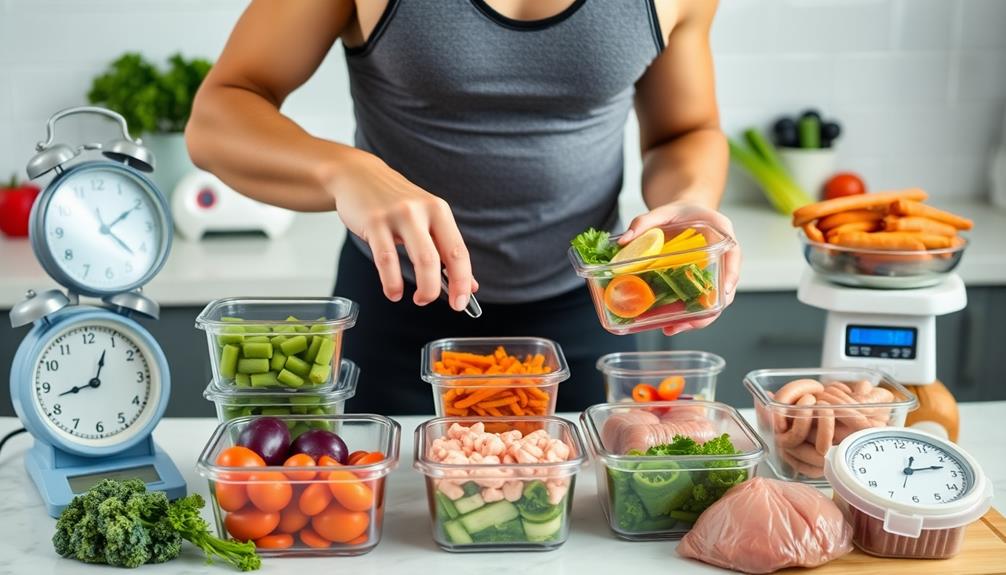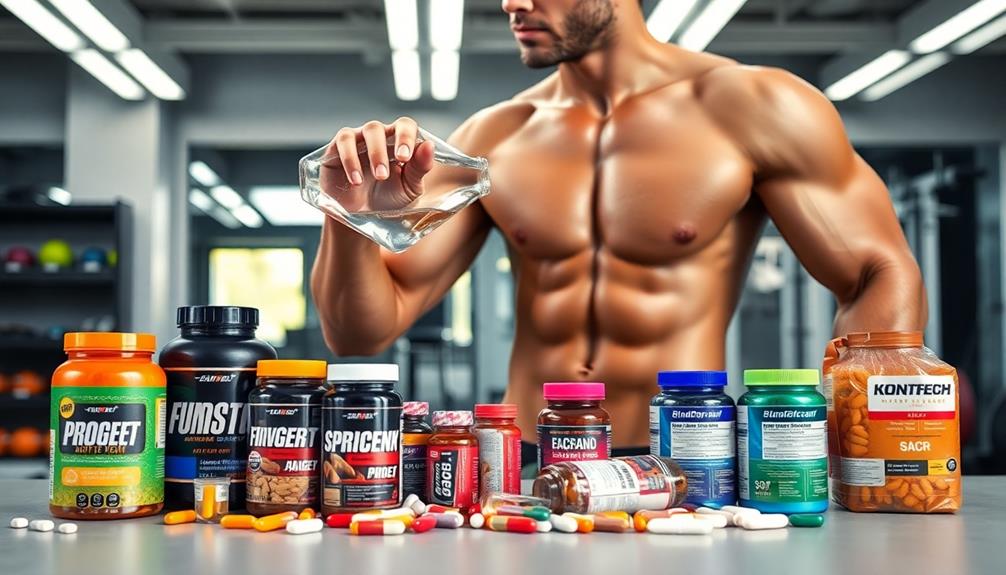To create an effective cutting diet plan for lean muscle, start by calculating your Total Daily Energy Expenditure (TDEE) and aim for a 10-20% calorie deficit. Balance your macronutrients with higher protein intake (30-35%), moderate carbs (25-30%), and healthy fats (25-30%). Spread 4-6 small meals throughout the day, focusing on lean protein sources like chicken breast, fish, and protein powders. Implement carbohydrate cycling, adjusting intake based on workout days. Stay hydrated and consider supplements to support your goals. Consistency is key in both diet and exercise for preserving muscle while losing fat. As you progress, you'll discover additional strategies to fine-tune your cutting plan.
Core Insight
- Calculate your TDEE and create a 10-20% caloric deficit to promote fat loss.
- Maintain high protein intake (1g per pound of body weight) to preserve muscle mass.
- Implement carbohydrate cycling, adjusting carb intake based on workout and rest days.
- Spread 4-6 small meals throughout the day to sustain energy and support metabolism.
- Choose lean protein sources and incorporate low-sugar energy bars to meet macronutrient goals.
Understanding Caloric Deficit

Want to achieve your lean muscle goals? It's all about calories and creating a caloric deficit. This means eating fewer calories than your body burns each day. It's the key to losing fat.
First, calculate your Total Daily Energy Expenditure (TDEE). This is the number of calories your body burns daily, including basic functions and exercise. Once you know your TDEE, aim to eat 10-20% fewer calories than this number.
For example, if your TDEE is 2,500 calories, try to eat 2,000-2,250 calories per day during your cutting phase. This deficit will make your body use stored fat for energy, helping you lose fat while keeping your muscle.
Non-stimulant fat burners can help with weight loss, but they work best when combined with a proper caloric deficit and exercise plan. Stick to your deficit and keep working out, and you'll be on your way to a leaner, stronger physique.
Calculating Macronutrient Ratios

When you've figured out your calorie deficit, it's time to think about macronutrients. Getting the right mix of protein, carbs, and fat is key for keeping muscle while losing fat. For a cutting diet, you'll usually want to eat more protein and fewer carbs. When planning your meals, think about adding in low-sugar energy bars as an easy snack to keep your energy up without messing up your macronutrient goals.
A basic guide for macronutrient ratios during a cutting phase is:
- Protein: 30-35% of total calories
- Carbs: 25-30% of total calories
- Fat: 25-30% of total calories
- Fiber: 25-30 grams per day
Meal Timing and Frequency

When cutting, meal timing and frequency are key. Spread out 4-6 small meals over the day to keep your energy up and muscles strong. Don't do 3 big meals.
Plan meals around workouts. Eat protein and carbs 2-3 hours before exercise. After, have a protein snack within 30 minutes to help muscles recover. Consider having fast carbs post-workout to restore glycogen and aid recovery.
Eat every 3-4 hours to rev your metabolism, but don't force it if you're not hungry. Pay attention to your body. Focus on hitting your daily calories and macros consistently. That matters more than perfect meal timing.
Protein Sources for Muscle Retention

Timing your meals right is key, but what you eat matters just as much. When cutting, focus on protein sources that keep your muscle mass intact. Lean proteins are your top pick since they give you the amino acids you need without extra calories. Protein powders can help too, packing a lot of protein with few calories. Try these great protein sources in your cutting diet:
- Chicken breast
- Lean beef cuts
- Fish (like salmon, tilapia, or cod)
- Egg whites or whole eggs
These foods are low in fat but high in protein, perfect for holding onto muscle while in a calorie deficit. Shoot for about 1 gram of protein per pound of body weight each day. And don't skip plant proteins like beans and tofu – they've got extra nutrients and fiber to keep you full.
Carbohydrate Cycling Strategies

Carbohydrate cycling is an effective way to lose fat while keeping muscle. It works by changing the amount of carbs you eat on different days. On days you work out, eat more carbs to fuel your training and restore energy. On days you rest, eat fewer carbs to burn more fat. Taking carbohydrate supplements after exercise can help on high-carb days to quickly restore energy and recover muscles.
To start carb cycling, first figure out how many calories you need each day. Then, change your carb amounts based on how active you are. On high-carb days, try to get 2-3g of carbs for each pound of your body weight. On low-carb days, lower this to 0.5-1g per pound. Keep your protein the same every day, and change your fat to reach your calorie goals. Focus on getting carbs from whole grains, fruits, and vegetables for steady energy and good health.
Importance of Healthy Fats

Healthy fats are a must-have in any cutting diet plan that works. You need them for making hormones, absorbing nutrients, and staying healthy while cutting calories. Don't cut out all the fat when you're eating less. Instead, make sure to include a moderate amount of healthy fats in your meals. The best healthy fats can really boost muscle growth and recovery during a cutting phase, so they're a crucial part of your diet.
Here's why you should eat healthy fats when cutting:
- They help regulate hormones, especially testosterone
- They keep you feeling full and satisfied for longer
- They improve absorption of vitamins A, D, E, and K
- They give you steady energy all day long
Choose foods like avocados, nuts, seeds, olive oil, and fatty fish. These have essential omega-3s and other nutrients that are good for you. Just remember to keep it in moderation – aim for about 20-30% of your daily calories from healthy fats. This will support your cutting goals and keep you in top shape.
Hydration and Supplements

Drinking enough water and using the right supplements can make a big difference in your cutting diet. During a cut, you need to drink more water to boost your metabolism and get rid of toxins. Try to drink at least 8-10 glasses of water every day. If you're working out hard, drink even more. Coconut water is a great choice because it has electrolytes that replace minerals you lose when you sweat. Some coconut water brands also have extra vitamins and potassium to help you reach your cutting goals.
Supplements can help you get the nutrition you need and improve your results. Think about using a good protein powder to help keep your muscles strong. BCAAs (branched-chain amino acids) can speed up recovery and prevent muscle loss. A multivitamin makes sure you're getting all the important nutrients. Omega-3 fatty acids can reduce inflammation and help you lose fat.
Adjusting Diet for Progress

As you progress through your cutting phase, it's crucial to keep an eye on your results and adjust your diet when needed. Your body's nutritional requirements will change as your composition changes. Monitor your weight, measurements, and energy levels to see if your current plan is effective. Supplements can help you maintain energy and retain muscle while cutting. They may help you stick to your diet and keep your lean mass.
When changing your diet, think about:
- Calories: If weight loss slows, gradually reduce your calorie intake
- Macros: Adjust protein, carbs, and fats if necessary
- Meal timing: Try different meal frequencies and pre/post-workout nutrition
- Foods: Choose nutrient-dense options to stay full
Small changes to your diet plan are okay. What works at first may not work as well later in your cutting phase. Be flexible and pay attention to your body. Focus on sustainable progress, not quick, short-term results.
Frequently Asked Questions
How Long Should a Cutting Phase Last?
You should typically aim for a cutting phase lasting 8-16 weeks. It depends on your starting point and goals. Don't rush it; slow and steady wins the race. Monitor your progress and adjust as needed.
Can I Have Cheat Meals During a Cutting Diet?
You can have occasional cheat meals during a cutting diet, but they should be planned and limited. It's best to stick to your diet 90% of the time. Moderation is key to avoid undoing your progress.
Should I Incorporate Fasting Into My Cutting Diet Plan?
You can incorporate fasting into your cutting diet plan. It may help with calorie control and fat loss. However, it's not necessary for everyone. Consider your lifestyle and preferences before implementing fasting. Consult a nutritionist for personalized advice.
How Do I Maintain Muscle Strength While Cutting?
To sustain muscle strength while cutting, you'll want to focus on high-protein intake, continue resistance training, and avoid drastic calorie reductions. You should also prioritize compound exercises and prioritize proper rest between workouts for peak recovery.
Is It Necessary to Count Calories From Vegetables During a Cut?
While it's not always necessary, counting vegetable calories can be beneficial. You'll get a more accurate picture of your total intake. However, most veggies are low-calorie, so you don't need to stress about them as much.

